Icon College: Sustainable and Responsible Management in Tourism Report
VerifiedAdded on 2022/12/05
|15
|4002
|272
Report
AI Summary
This report delves into the critical analysis of sustainable and responsible tourism, examining the impact of tourism on the environment, culture, and local communities. It explores the differences in sustainability practices between destination tourism and hospitality organizations, highlighting their individual approaches to environmental protection, resource management, and community engagement. The report further discusses the principles of sustainable tourism and development, emphasizing the importance of minimizing negative impacts, promoting economic benefits, and preserving natural and cultural heritage. The report analyzes case studies such as Bees Elephant Sanctuary, Inkaterra Hotel, and Wavelength, offering practical examples of sustainable tourism in action. The report concludes by emphasizing the importance of sustainable practices for the long-term viability of the tourism industry and the preservation of natural resources.
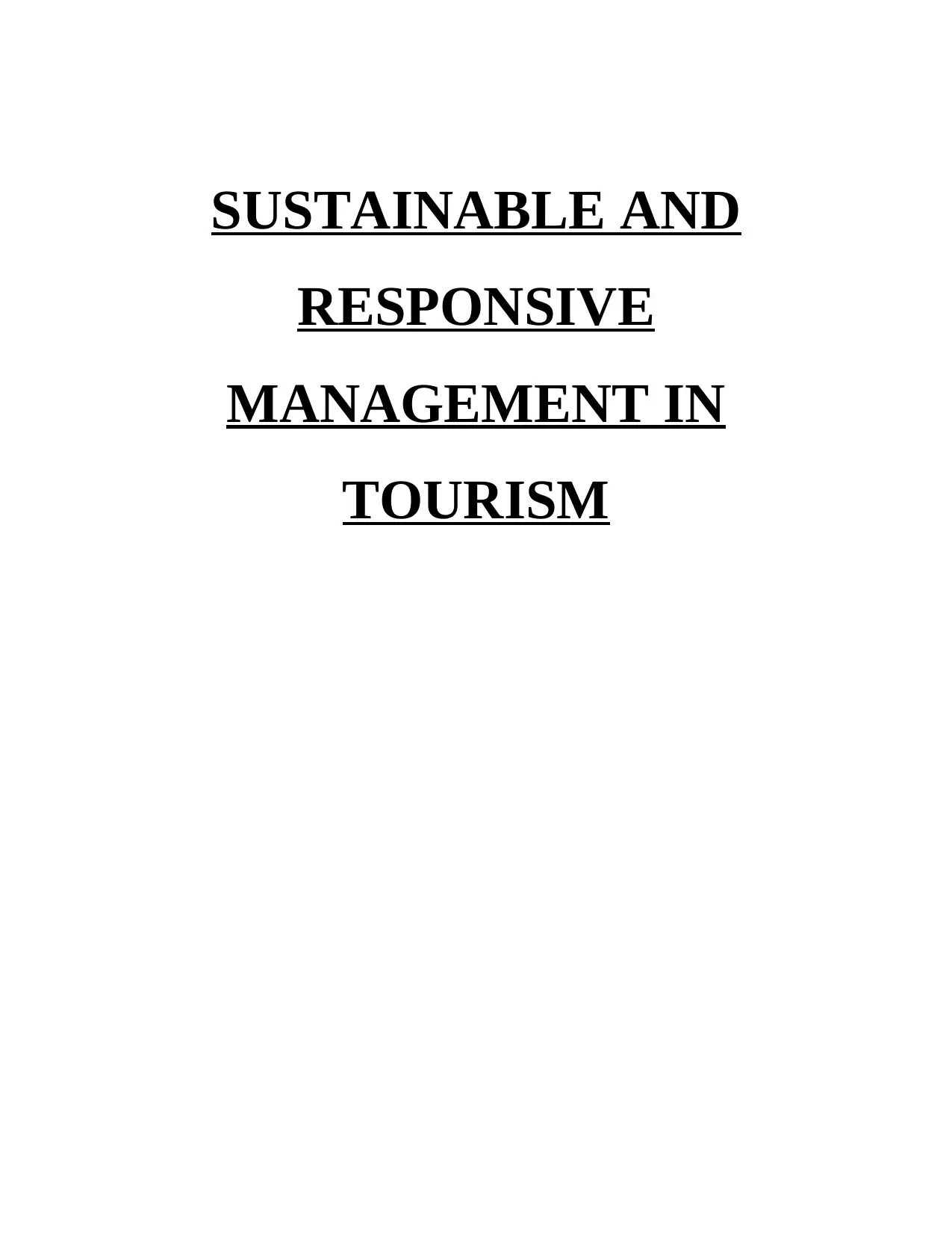
SUSTAINABLE AND
RESPONSIVE
MANAGEMENT IN
TOURISM
RESPONSIVE
MANAGEMENT IN
TOURISM
Paraphrase This Document
Need a fresh take? Get an instant paraphrase of this document with our AI Paraphraser
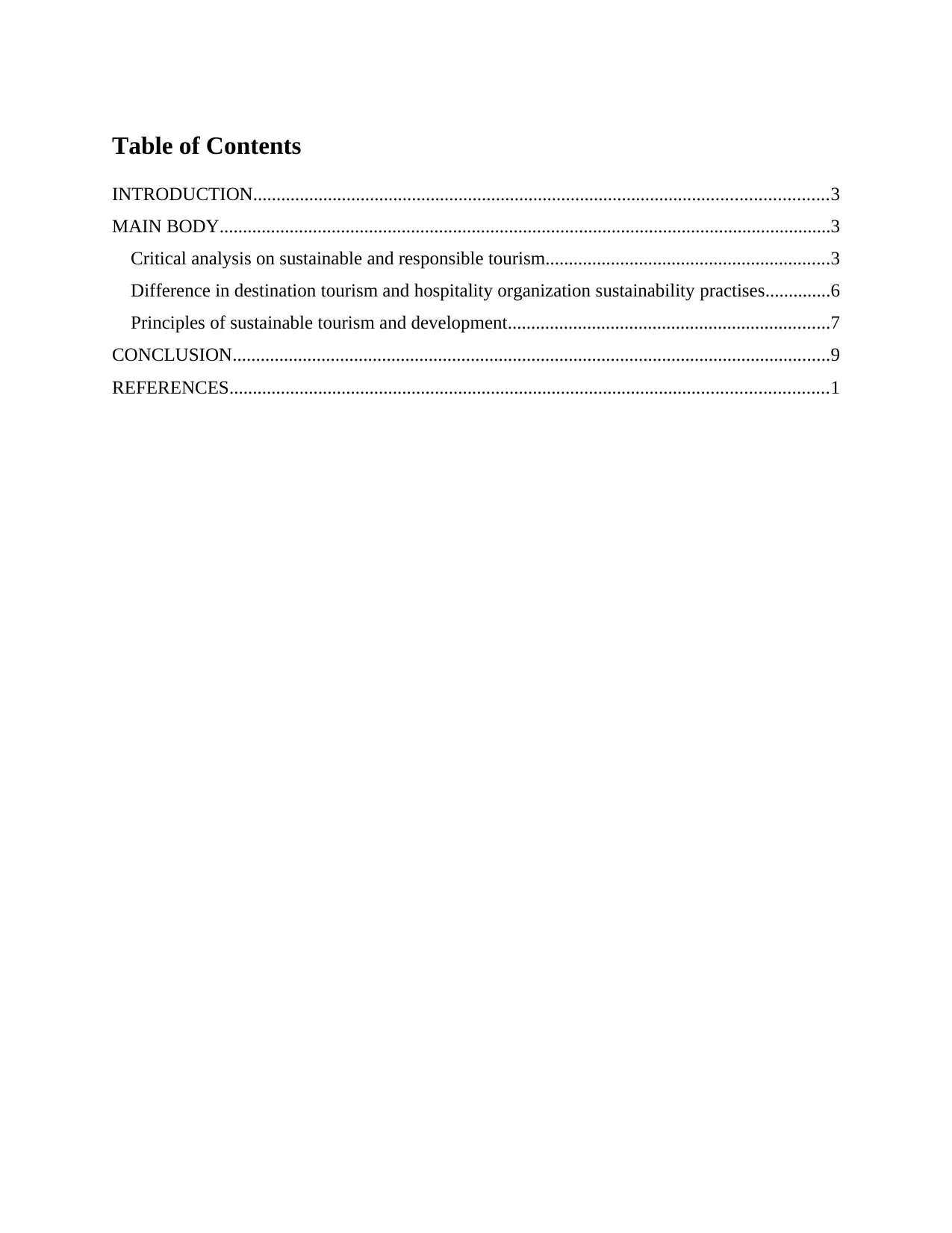
Table of Contents
INTRODUCTION...........................................................................................................................3
MAIN BODY...................................................................................................................................3
Critical analysis on sustainable and responsible tourism.............................................................3
Difference in destination tourism and hospitality organization sustainability practises..............6
Principles of sustainable tourism and development.....................................................................7
CONCLUSION................................................................................................................................9
REFERENCES................................................................................................................................1
INTRODUCTION...........................................................................................................................3
MAIN BODY...................................................................................................................................3
Critical analysis on sustainable and responsible tourism.............................................................3
Difference in destination tourism and hospitality organization sustainability practises..............6
Principles of sustainable tourism and development.....................................................................7
CONCLUSION................................................................................................................................9
REFERENCES................................................................................................................................1
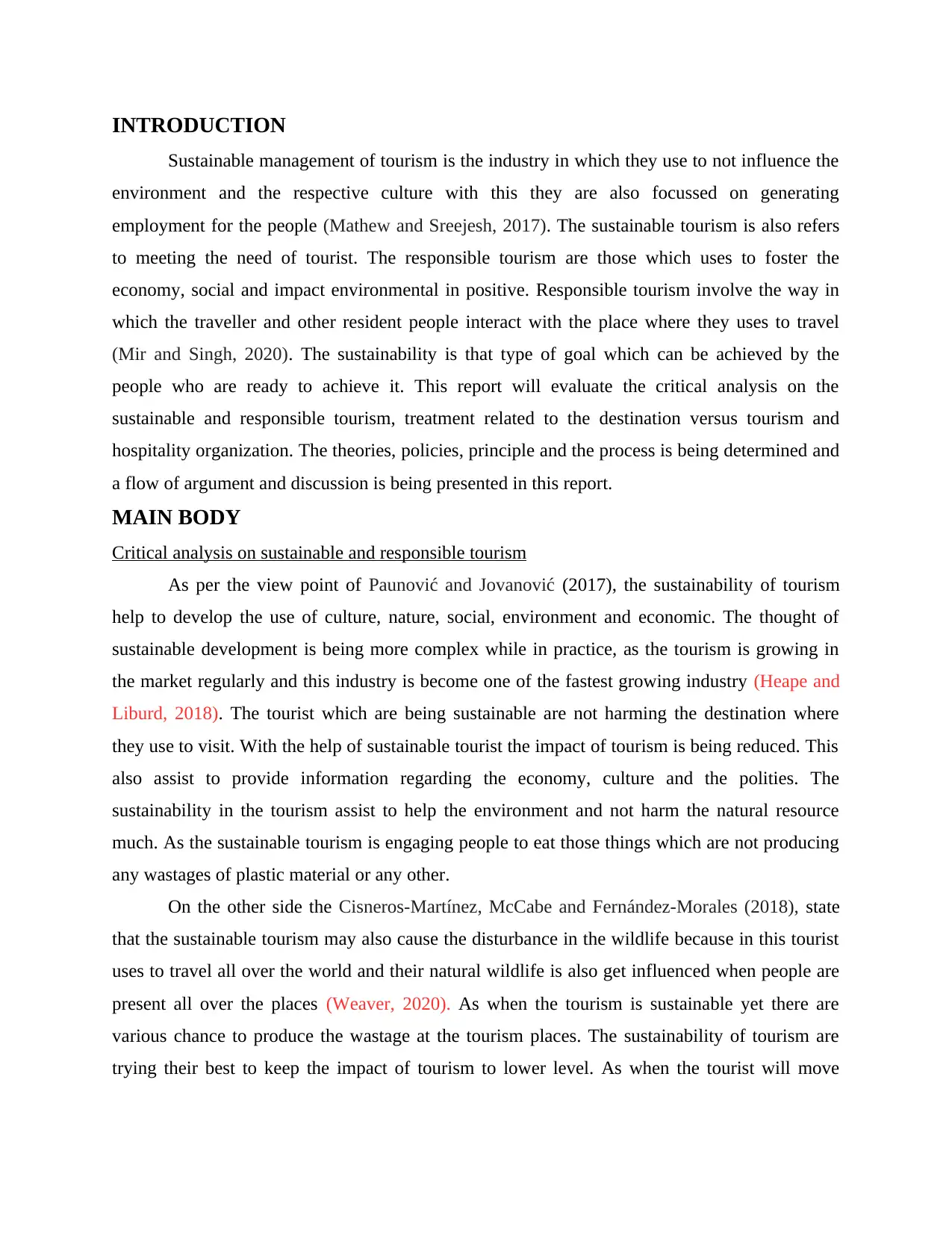
INTRODUCTION
Sustainable management of tourism is the industry in which they use to not influence the
environment and the respective culture with this they are also focussed on generating
employment for the people (Mathew and Sreejesh, 2017). The sustainable tourism is also refers
to meeting the need of tourist. The responsible tourism are those which uses to foster the
economy, social and impact environmental in positive. Responsible tourism involve the way in
which the traveller and other resident people interact with the place where they uses to travel
(Mir and Singh, 2020). The sustainability is that type of goal which can be achieved by the
people who are ready to achieve it. This report will evaluate the critical analysis on the
sustainable and responsible tourism, treatment related to the destination versus tourism and
hospitality organization. The theories, policies, principle and the process is being determined and
a flow of argument and discussion is being presented in this report.
MAIN BODY
Critical analysis on sustainable and responsible tourism
As per the view point of Paunović and Jovanović (2017), the sustainability of tourism
help to develop the use of culture, nature, social, environment and economic. The thought of
sustainable development is being more complex while in practice, as the tourism is growing in
the market regularly and this industry is become one of the fastest growing industry (Heape and
Liburd, 2018). The tourist which are being sustainable are not harming the destination where
they use to visit. With the help of sustainable tourist the impact of tourism is being reduced. This
also assist to provide information regarding the economy, culture and the polities. The
sustainability in the tourism assist to help the environment and not harm the natural resource
much. As the sustainable tourism is engaging people to eat those things which are not producing
any wastages of plastic material or any other.
On the other side the Cisneros-Martínez, McCabe and Fernández-Morales (2018), state
that the sustainable tourism may also cause the disturbance in the wildlife because in this tourist
uses to travel all over the world and their natural wildlife is also get influenced when people are
present all over the places (Weaver, 2020). As when the tourism is sustainable yet there are
various chance to produce the wastage at the tourism places. The sustainability of tourism are
trying their best to keep the impact of tourism to lower level. As when the tourist will move
Sustainable management of tourism is the industry in which they use to not influence the
environment and the respective culture with this they are also focussed on generating
employment for the people (Mathew and Sreejesh, 2017). The sustainable tourism is also refers
to meeting the need of tourist. The responsible tourism are those which uses to foster the
economy, social and impact environmental in positive. Responsible tourism involve the way in
which the traveller and other resident people interact with the place where they uses to travel
(Mir and Singh, 2020). The sustainability is that type of goal which can be achieved by the
people who are ready to achieve it. This report will evaluate the critical analysis on the
sustainable and responsible tourism, treatment related to the destination versus tourism and
hospitality organization. The theories, policies, principle and the process is being determined and
a flow of argument and discussion is being presented in this report.
MAIN BODY
Critical analysis on sustainable and responsible tourism
As per the view point of Paunović and Jovanović (2017), the sustainability of tourism
help to develop the use of culture, nature, social, environment and economic. The thought of
sustainable development is being more complex while in practice, as the tourism is growing in
the market regularly and this industry is become one of the fastest growing industry (Heape and
Liburd, 2018). The tourist which are being sustainable are not harming the destination where
they use to visit. With the help of sustainable tourist the impact of tourism is being reduced. This
also assist to provide information regarding the economy, culture and the polities. The
sustainability in the tourism assist to help the environment and not harm the natural resource
much. As the sustainable tourism is engaging people to eat those things which are not producing
any wastages of plastic material or any other.
On the other side the Cisneros-Martínez, McCabe and Fernández-Morales (2018), state
that the sustainable tourism may also cause the disturbance in the wildlife because in this tourist
uses to travel all over the world and their natural wildlife is also get influenced when people are
present all over the places (Weaver, 2020). As when the tourism is sustainable yet there are
various chance to produce the wastage at the tourism places. The sustainability of tourism are
trying their best to keep the impact of tourism to lower level. As when the tourist will move
⊘ This is a preview!⊘
Do you want full access?
Subscribe today to unlock all pages.

Trusted by 1+ million students worldwide
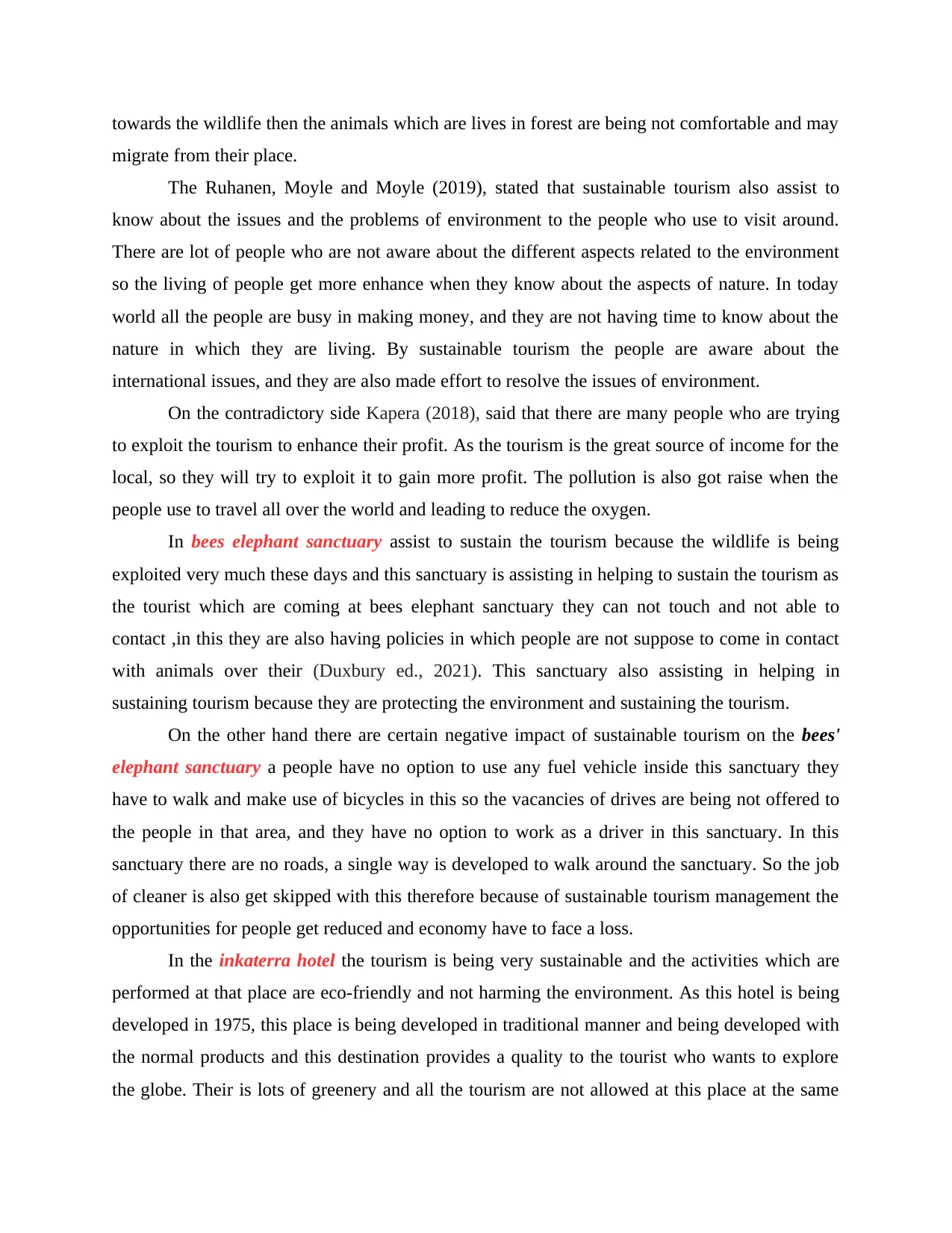
towards the wildlife then the animals which are lives in forest are being not comfortable and may
migrate from their place.
The Ruhanen, Moyle and Moyle (2019), stated that sustainable tourism also assist to
know about the issues and the problems of environment to the people who use to visit around.
There are lot of people who are not aware about the different aspects related to the environment
so the living of people get more enhance when they know about the aspects of nature. In today
world all the people are busy in making money, and they are not having time to know about the
nature in which they are living. By sustainable tourism the people are aware about the
international issues, and they are also made effort to resolve the issues of environment.
On the contradictory side Kapera (2018), said that there are many people who are trying
to exploit the tourism to enhance their profit. As the tourism is the great source of income for the
local, so they will try to exploit it to gain more profit. The pollution is also got raise when the
people use to travel all over the world and leading to reduce the oxygen.
In bees elephant sanctuary assist to sustain the tourism because the wildlife is being
exploited very much these days and this sanctuary is assisting in helping to sustain the tourism as
the tourist which are coming at bees elephant sanctuary they can not touch and not able to
contact ,in this they are also having policies in which people are not suppose to come in contact
with animals over their (Duxbury ed., 2021). This sanctuary also assisting in helping in
sustaining tourism because they are protecting the environment and sustaining the tourism.
On the other hand there are certain negative impact of sustainable tourism on the bees'
elephant sanctuary a people have no option to use any fuel vehicle inside this sanctuary they
have to walk and make use of bicycles in this so the vacancies of drives are being not offered to
the people in that area, and they have no option to work as a driver in this sanctuary. In this
sanctuary there are no roads, a single way is developed to walk around the sanctuary. So the job
of cleaner is also get skipped with this therefore because of sustainable tourism management the
opportunities for people get reduced and economy have to face a loss.
In the inkaterra hotel the tourism is being very sustainable and the activities which are
performed at that place are eco-friendly and not harming the environment. As this hotel is being
developed in 1975, this place is being developed in traditional manner and being developed with
the normal products and this destination provides a quality to the tourist who wants to explore
the globe. Their is lots of greenery and all the tourism are not allowed at this place at the same
migrate from their place.
The Ruhanen, Moyle and Moyle (2019), stated that sustainable tourism also assist to
know about the issues and the problems of environment to the people who use to visit around.
There are lot of people who are not aware about the different aspects related to the environment
so the living of people get more enhance when they know about the aspects of nature. In today
world all the people are busy in making money, and they are not having time to know about the
nature in which they are living. By sustainable tourism the people are aware about the
international issues, and they are also made effort to resolve the issues of environment.
On the contradictory side Kapera (2018), said that there are many people who are trying
to exploit the tourism to enhance their profit. As the tourism is the great source of income for the
local, so they will try to exploit it to gain more profit. The pollution is also got raise when the
people use to travel all over the world and leading to reduce the oxygen.
In bees elephant sanctuary assist to sustain the tourism because the wildlife is being
exploited very much these days and this sanctuary is assisting in helping to sustain the tourism as
the tourist which are coming at bees elephant sanctuary they can not touch and not able to
contact ,in this they are also having policies in which people are not suppose to come in contact
with animals over their (Duxbury ed., 2021). This sanctuary also assisting in helping in
sustaining tourism because they are protecting the environment and sustaining the tourism.
On the other hand there are certain negative impact of sustainable tourism on the bees'
elephant sanctuary a people have no option to use any fuel vehicle inside this sanctuary they
have to walk and make use of bicycles in this so the vacancies of drives are being not offered to
the people in that area, and they have no option to work as a driver in this sanctuary. In this
sanctuary there are no roads, a single way is developed to walk around the sanctuary. So the job
of cleaner is also get skipped with this therefore because of sustainable tourism management the
opportunities for people get reduced and economy have to face a loss.
In the inkaterra hotel the tourism is being very sustainable and the activities which are
performed at that place are eco-friendly and not harming the environment. As this hotel is being
developed in 1975, this place is being developed in traditional manner and being developed with
the normal products and this destination provides a quality to the tourist who wants to explore
the globe. Their is lots of greenery and all the tourism are not allowed at this place at the same
Paraphrase This Document
Need a fresh take? Get an instant paraphrase of this document with our AI Paraphraser
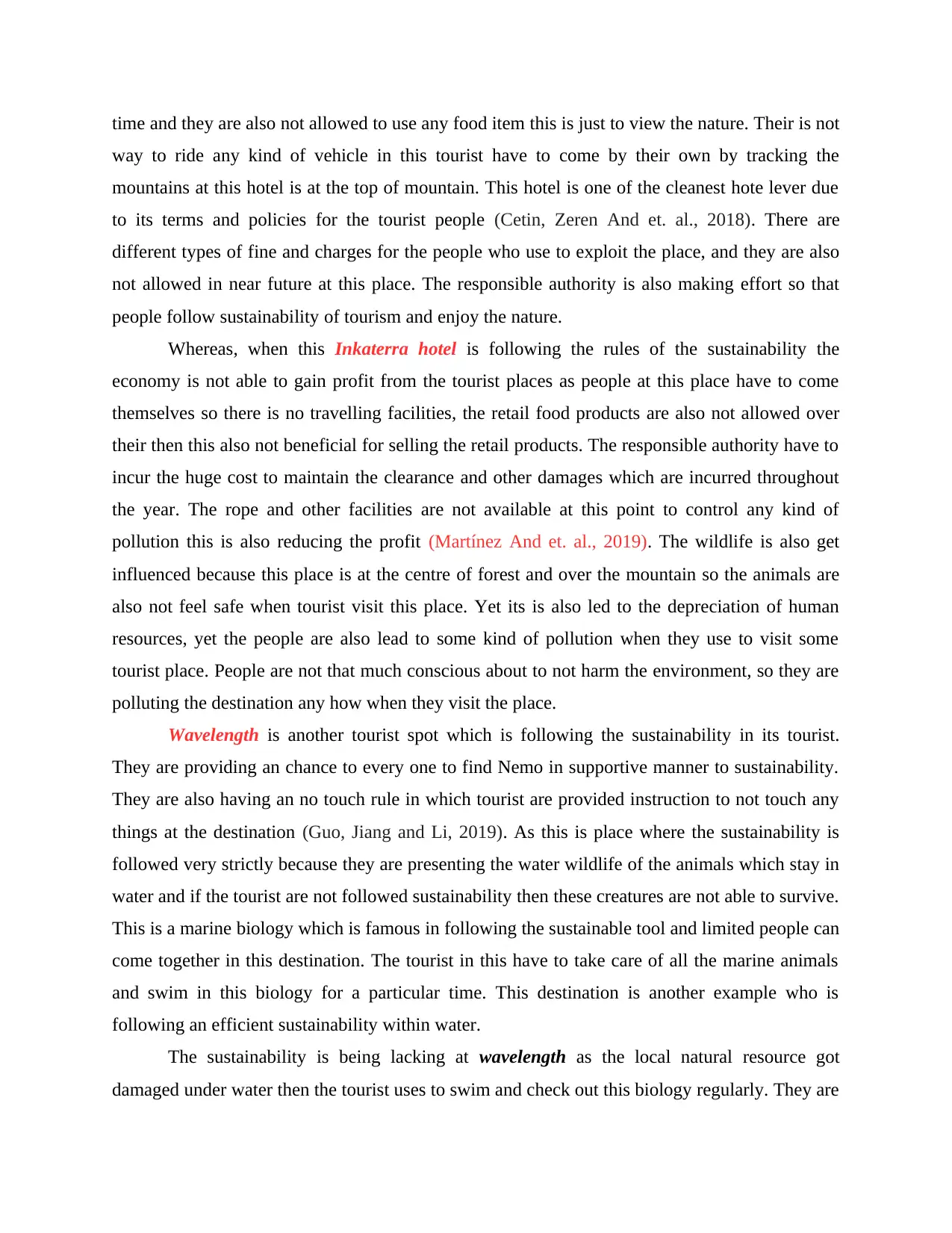
time and they are also not allowed to use any food item this is just to view the nature. Their is not
way to ride any kind of vehicle in this tourist have to come by their own by tracking the
mountains at this hotel is at the top of mountain. This hotel is one of the cleanest hote lever due
to its terms and policies for the tourist people (Cetin, Zeren And et. al., 2018). There are
different types of fine and charges for the people who use to exploit the place, and they are also
not allowed in near future at this place. The responsible authority is also making effort so that
people follow sustainability of tourism and enjoy the nature.
Whereas, when this Inkaterra hotel is following the rules of the sustainability the
economy is not able to gain profit from the tourist places as people at this place have to come
themselves so there is no travelling facilities, the retail food products are also not allowed over
their then this also not beneficial for selling the retail products. The responsible authority have to
incur the huge cost to maintain the clearance and other damages which are incurred throughout
the year. The rope and other facilities are not available at this point to control any kind of
pollution this is also reducing the profit (Martínez And et. al., 2019). The wildlife is also get
influenced because this place is at the centre of forest and over the mountain so the animals are
also not feel safe when tourist visit this place. Yet its is also led to the depreciation of human
resources, yet the people are also lead to some kind of pollution when they use to visit some
tourist place. People are not that much conscious about to not harm the environment, so they are
polluting the destination any how when they visit the place.
Wavelength is another tourist spot which is following the sustainability in its tourist.
They are providing an chance to every one to find Nemo in supportive manner to sustainability.
They are also having an no touch rule in which tourist are provided instruction to not touch any
things at the destination (Guo, Jiang and Li, 2019). As this is place where the sustainability is
followed very strictly because they are presenting the water wildlife of the animals which stay in
water and if the tourist are not followed sustainability then these creatures are not able to survive.
This is a marine biology which is famous in following the sustainable tool and limited people can
come together in this destination. The tourist in this have to take care of all the marine animals
and swim in this biology for a particular time. This destination is another example who is
following an efficient sustainability within water.
The sustainability is being lacking at wavelength as the local natural resource got
damaged under water then the tourist uses to swim and check out this biology regularly. They are
way to ride any kind of vehicle in this tourist have to come by their own by tracking the
mountains at this hotel is at the top of mountain. This hotel is one of the cleanest hote lever due
to its terms and policies for the tourist people (Cetin, Zeren And et. al., 2018). There are
different types of fine and charges for the people who use to exploit the place, and they are also
not allowed in near future at this place. The responsible authority is also making effort so that
people follow sustainability of tourism and enjoy the nature.
Whereas, when this Inkaterra hotel is following the rules of the sustainability the
economy is not able to gain profit from the tourist places as people at this place have to come
themselves so there is no travelling facilities, the retail food products are also not allowed over
their then this also not beneficial for selling the retail products. The responsible authority have to
incur the huge cost to maintain the clearance and other damages which are incurred throughout
the year. The rope and other facilities are not available at this point to control any kind of
pollution this is also reducing the profit (Martínez And et. al., 2019). The wildlife is also get
influenced because this place is at the centre of forest and over the mountain so the animals are
also not feel safe when tourist visit this place. Yet its is also led to the depreciation of human
resources, yet the people are also lead to some kind of pollution when they use to visit some
tourist place. People are not that much conscious about to not harm the environment, so they are
polluting the destination any how when they visit the place.
Wavelength is another tourist spot which is following the sustainability in its tourist.
They are providing an chance to every one to find Nemo in supportive manner to sustainability.
They are also having an no touch rule in which tourist are provided instruction to not touch any
things at the destination (Guo, Jiang and Li, 2019). As this is place where the sustainability is
followed very strictly because they are presenting the water wildlife of the animals which stay in
water and if the tourist are not followed sustainability then these creatures are not able to survive.
This is a marine biology which is famous in following the sustainable tool and limited people can
come together in this destination. The tourist in this have to take care of all the marine animals
and swim in this biology for a particular time. This destination is another example who is
following an efficient sustainability within water.
The sustainability is being lacking at wavelength as the local natural resource got
damaged under water then the tourist uses to swim and check out this biology regularly. They are
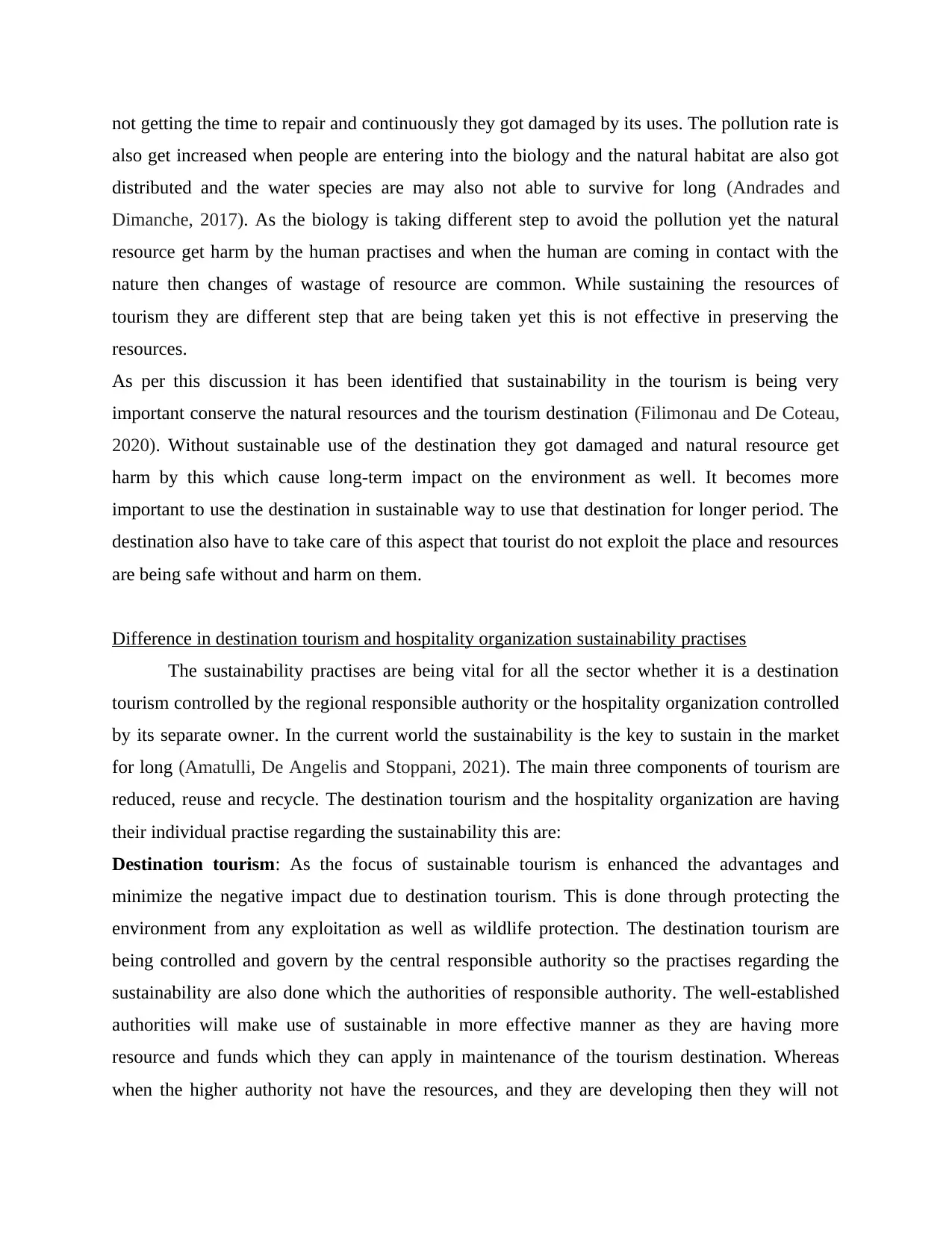
not getting the time to repair and continuously they got damaged by its uses. The pollution rate is
also get increased when people are entering into the biology and the natural habitat are also got
distributed and the water species are may also not able to survive for long (Andrades and
Dimanche, 2017). As the biology is taking different step to avoid the pollution yet the natural
resource get harm by the human practises and when the human are coming in contact with the
nature then changes of wastage of resource are common. While sustaining the resources of
tourism they are different step that are being taken yet this is not effective in preserving the
resources.
As per this discussion it has been identified that sustainability in the tourism is being very
important conserve the natural resources and the tourism destination (Filimonau and De Coteau,
2020). Without sustainable use of the destination they got damaged and natural resource get
harm by this which cause long-term impact on the environment as well. It becomes more
important to use the destination in sustainable way to use that destination for longer period. The
destination also have to take care of this aspect that tourist do not exploit the place and resources
are being safe without and harm on them.
Difference in destination tourism and hospitality organization sustainability practises
The sustainability practises are being vital for all the sector whether it is a destination
tourism controlled by the regional responsible authority or the hospitality organization controlled
by its separate owner. In the current world the sustainability is the key to sustain in the market
for long (Amatulli, De Angelis and Stoppani, 2021). The main three components of tourism are
reduced, reuse and recycle. The destination tourism and the hospitality organization are having
their individual practise regarding the sustainability this are:
Destination tourism: As the focus of sustainable tourism is enhanced the advantages and
minimize the negative impact due to destination tourism. This is done through protecting the
environment from any exploitation as well as wildlife protection. The destination tourism are
being controlled and govern by the central responsible authority so the practises regarding the
sustainability are also done which the authorities of responsible authority. The well-established
authorities will make use of sustainable in more effective manner as they are having more
resource and funds which they can apply in maintenance of the tourism destination. Whereas
when the higher authority not have the resources, and they are developing then they will not
also get increased when people are entering into the biology and the natural habitat are also got
distributed and the water species are may also not able to survive for long (Andrades and
Dimanche, 2017). As the biology is taking different step to avoid the pollution yet the natural
resource get harm by the human practises and when the human are coming in contact with the
nature then changes of wastage of resource are common. While sustaining the resources of
tourism they are different step that are being taken yet this is not effective in preserving the
resources.
As per this discussion it has been identified that sustainability in the tourism is being very
important conserve the natural resources and the tourism destination (Filimonau and De Coteau,
2020). Without sustainable use of the destination they got damaged and natural resource get
harm by this which cause long-term impact on the environment as well. It becomes more
important to use the destination in sustainable way to use that destination for longer period. The
destination also have to take care of this aspect that tourist do not exploit the place and resources
are being safe without and harm on them.
Difference in destination tourism and hospitality organization sustainability practises
The sustainability practises are being vital for all the sector whether it is a destination
tourism controlled by the regional responsible authority or the hospitality organization controlled
by its separate owner. In the current world the sustainability is the key to sustain in the market
for long (Amatulli, De Angelis and Stoppani, 2021). The main three components of tourism are
reduced, reuse and recycle. The destination tourism and the hospitality organization are having
their individual practise regarding the sustainability this are:
Destination tourism: As the focus of sustainable tourism is enhanced the advantages and
minimize the negative impact due to destination tourism. This is done through protecting the
environment from any exploitation as well as wildlife protection. The destination tourism are
being controlled and govern by the central responsible authority so the practises regarding the
sustainability are also done which the authorities of responsible authority. The well-established
authorities will make use of sustainable in more effective manner as they are having more
resource and funds which they can apply in maintenance of the tourism destination. Whereas
when the higher authority not have the resources, and they are developing then they will not
⊘ This is a preview!⊘
Do you want full access?
Subscribe today to unlock all pages.

Trusted by 1+ million students worldwide
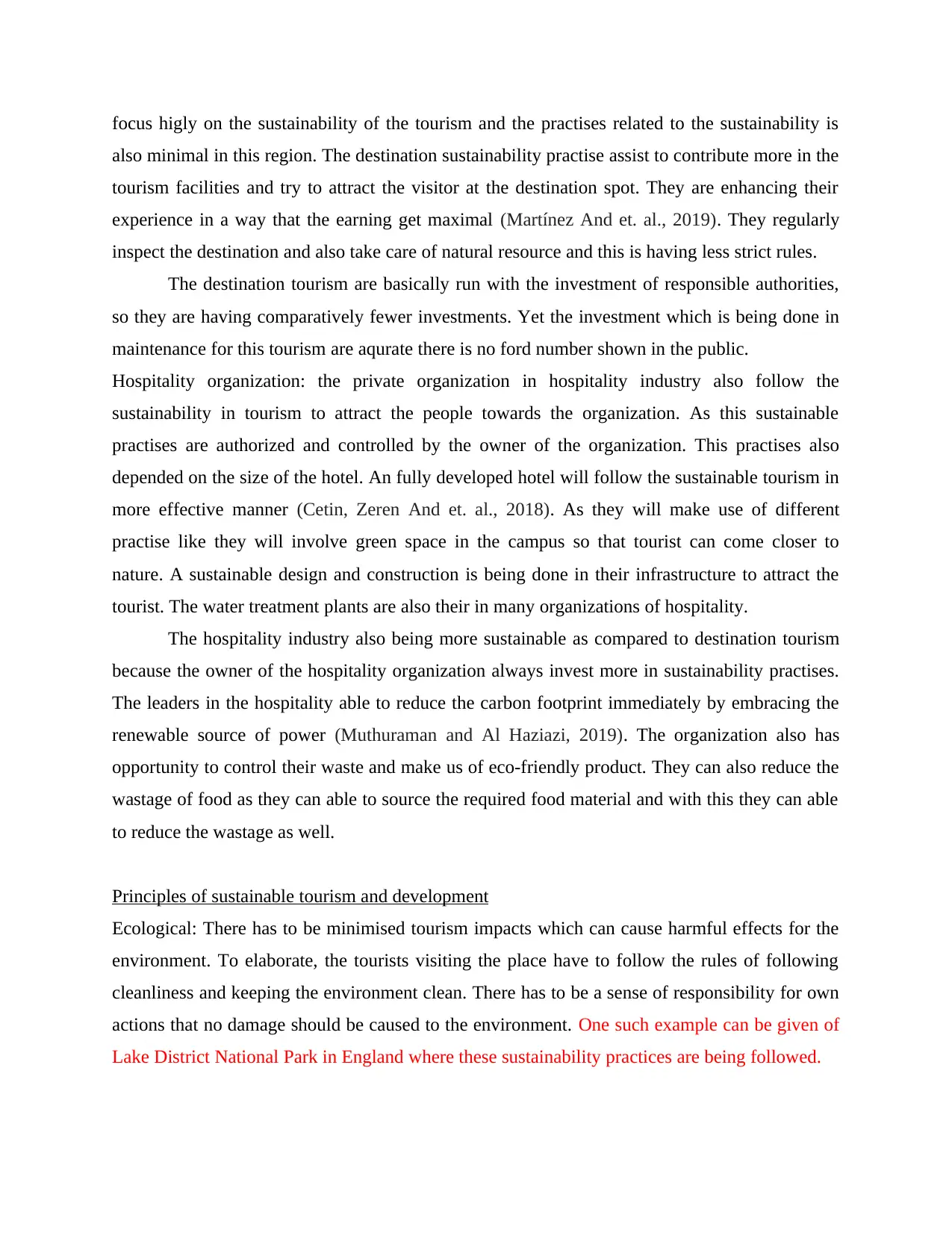
focus higly on the sustainability of the tourism and the practises related to the sustainability is
also minimal in this region. The destination sustainability practise assist to contribute more in the
tourism facilities and try to attract the visitor at the destination spot. They are enhancing their
experience in a way that the earning get maximal (Martínez And et. al., 2019). They regularly
inspect the destination and also take care of natural resource and this is having less strict rules.
The destination tourism are basically run with the investment of responsible authorities,
so they are having comparatively fewer investments. Yet the investment which is being done in
maintenance for this tourism are aqurate there is no ford number shown in the public.
Hospitality organization: the private organization in hospitality industry also follow the
sustainability in tourism to attract the people towards the organization. As this sustainable
practises are authorized and controlled by the owner of the organization. This practises also
depended on the size of the hotel. An fully developed hotel will follow the sustainable tourism in
more effective manner (Cetin, Zeren And et. al., 2018). As they will make use of different
practise like they will involve green space in the campus so that tourist can come closer to
nature. A sustainable design and construction is being done in their infrastructure to attract the
tourist. The water treatment plants are also their in many organizations of hospitality.
The hospitality industry also being more sustainable as compared to destination tourism
because the owner of the hospitality organization always invest more in sustainability practises.
The leaders in the hospitality able to reduce the carbon footprint immediately by embracing the
renewable source of power (Muthuraman and Al Haziazi, 2019). The organization also has
opportunity to control their waste and make us of eco-friendly product. They can also reduce the
wastage of food as they can able to source the required food material and with this they can able
to reduce the wastage as well.
Principles of sustainable tourism and development
Ecological: There has to be minimised tourism impacts which can cause harmful effects for the
environment. To elaborate, the tourists visiting the place have to follow the rules of following
cleanliness and keeping the environment clean. There has to be a sense of responsibility for own
actions that no damage should be caused to the environment. One such example can be given of
Lake District National Park in England where these sustainability practices are being followed.
also minimal in this region. The destination sustainability practise assist to contribute more in the
tourism facilities and try to attract the visitor at the destination spot. They are enhancing their
experience in a way that the earning get maximal (Martínez And et. al., 2019). They regularly
inspect the destination and also take care of natural resource and this is having less strict rules.
The destination tourism are basically run with the investment of responsible authorities,
so they are having comparatively fewer investments. Yet the investment which is being done in
maintenance for this tourism are aqurate there is no ford number shown in the public.
Hospitality organization: the private organization in hospitality industry also follow the
sustainability in tourism to attract the people towards the organization. As this sustainable
practises are authorized and controlled by the owner of the organization. This practises also
depended on the size of the hotel. An fully developed hotel will follow the sustainable tourism in
more effective manner (Cetin, Zeren And et. al., 2018). As they will make use of different
practise like they will involve green space in the campus so that tourist can come closer to
nature. A sustainable design and construction is being done in their infrastructure to attract the
tourist. The water treatment plants are also their in many organizations of hospitality.
The hospitality industry also being more sustainable as compared to destination tourism
because the owner of the hospitality organization always invest more in sustainability practises.
The leaders in the hospitality able to reduce the carbon footprint immediately by embracing the
renewable source of power (Muthuraman and Al Haziazi, 2019). The organization also has
opportunity to control their waste and make us of eco-friendly product. They can also reduce the
wastage of food as they can able to source the required food material and with this they can able
to reduce the wastage as well.
Principles of sustainable tourism and development
Ecological: There has to be minimised tourism impacts which can cause harmful effects for the
environment. To elaborate, the tourists visiting the place have to follow the rules of following
cleanliness and keeping the environment clean. There has to be a sense of responsibility for own
actions that no damage should be caused to the environment. One such example can be given of
Lake District National Park in England where these sustainability practices are being followed.
Paraphrase This Document
Need a fresh take? Get an instant paraphrase of this document with our AI Paraphraser
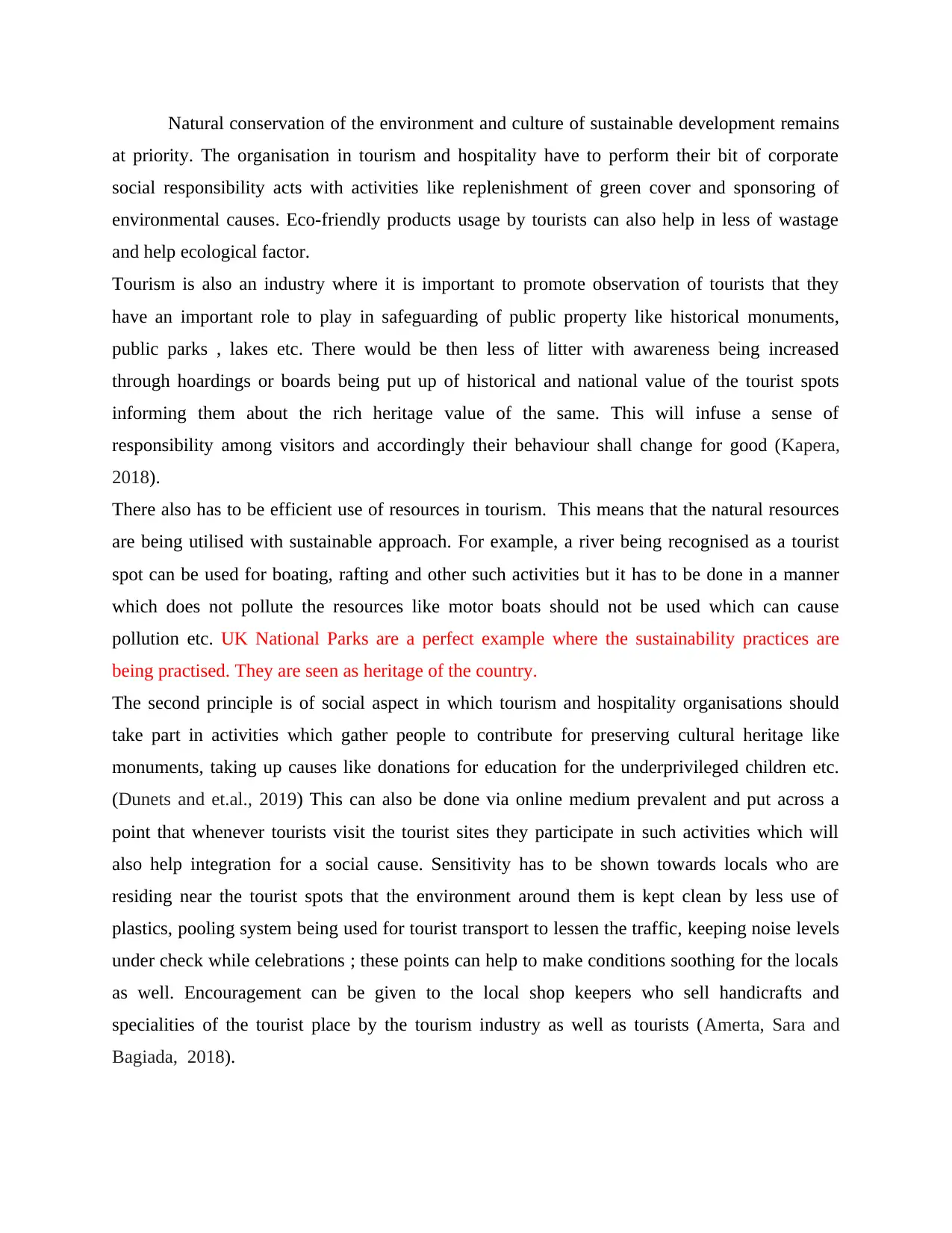
Natural conservation of the environment and culture of sustainable development remains
at priority. The organisation in tourism and hospitality have to perform their bit of corporate
social responsibility acts with activities like replenishment of green cover and sponsoring of
environmental causes. Eco-friendly products usage by tourists can also help in less of wastage
and help ecological factor.
Tourism is also an industry where it is important to promote observation of tourists that they
have an important role to play in safeguarding of public property like historical monuments,
public parks , lakes etc. There would be then less of litter with awareness being increased
through hoardings or boards being put up of historical and national value of the tourist spots
informing them about the rich heritage value of the same. This will infuse a sense of
responsibility among visitors and accordingly their behaviour shall change for good (Kapera,
2018).
There also has to be efficient use of resources in tourism. This means that the natural resources
are being utilised with sustainable approach. For example, a river being recognised as a tourist
spot can be used for boating, rafting and other such activities but it has to be done in a manner
which does not pollute the resources like motor boats should not be used which can cause
pollution etc. UK National Parks are a perfect example where the sustainability practices are
being practised. They are seen as heritage of the country.
The second principle is of social aspect in which tourism and hospitality organisations should
take part in activities which gather people to contribute for preserving cultural heritage like
monuments, taking up causes like donations for education for the underprivileged children etc.
(Dunets and et.al., 2019) This can also be done via online medium prevalent and put across a
point that whenever tourists visit the tourist sites they participate in such activities which will
also help integration for a social cause. Sensitivity has to be shown towards locals who are
residing near the tourist spots that the environment around them is kept clean by less use of
plastics, pooling system being used for tourist transport to lessen the traffic, keeping noise levels
under check while celebrations ; these points can help to make conditions soothing for the locals
as well. Encouragement can be given to the local shop keepers who sell handicrafts and
specialities of the tourist place by the tourism industry as well as tourists (Amerta, Sara and
Bagiada, 2018).
at priority. The organisation in tourism and hospitality have to perform their bit of corporate
social responsibility acts with activities like replenishment of green cover and sponsoring of
environmental causes. Eco-friendly products usage by tourists can also help in less of wastage
and help ecological factor.
Tourism is also an industry where it is important to promote observation of tourists that they
have an important role to play in safeguarding of public property like historical monuments,
public parks , lakes etc. There would be then less of litter with awareness being increased
through hoardings or boards being put up of historical and national value of the tourist spots
informing them about the rich heritage value of the same. This will infuse a sense of
responsibility among visitors and accordingly their behaviour shall change for good (Kapera,
2018).
There also has to be efficient use of resources in tourism. This means that the natural resources
are being utilised with sustainable approach. For example, a river being recognised as a tourist
spot can be used for boating, rafting and other such activities but it has to be done in a manner
which does not pollute the resources like motor boats should not be used which can cause
pollution etc. UK National Parks are a perfect example where the sustainability practices are
being practised. They are seen as heritage of the country.
The second principle is of social aspect in which tourism and hospitality organisations should
take part in activities which gather people to contribute for preserving cultural heritage like
monuments, taking up causes like donations for education for the underprivileged children etc.
(Dunets and et.al., 2019) This can also be done via online medium prevalent and put across a
point that whenever tourists visit the tourist sites they participate in such activities which will
also help integration for a social cause. Sensitivity has to be shown towards locals who are
residing near the tourist spots that the environment around them is kept clean by less use of
plastics, pooling system being used for tourist transport to lessen the traffic, keeping noise levels
under check while celebrations ; these points can help to make conditions soothing for the locals
as well. Encouragement can be given to the local shop keepers who sell handicrafts and
specialities of the tourist place by the tourism industry as well as tourists (Amerta, Sara and
Bagiada, 2018).
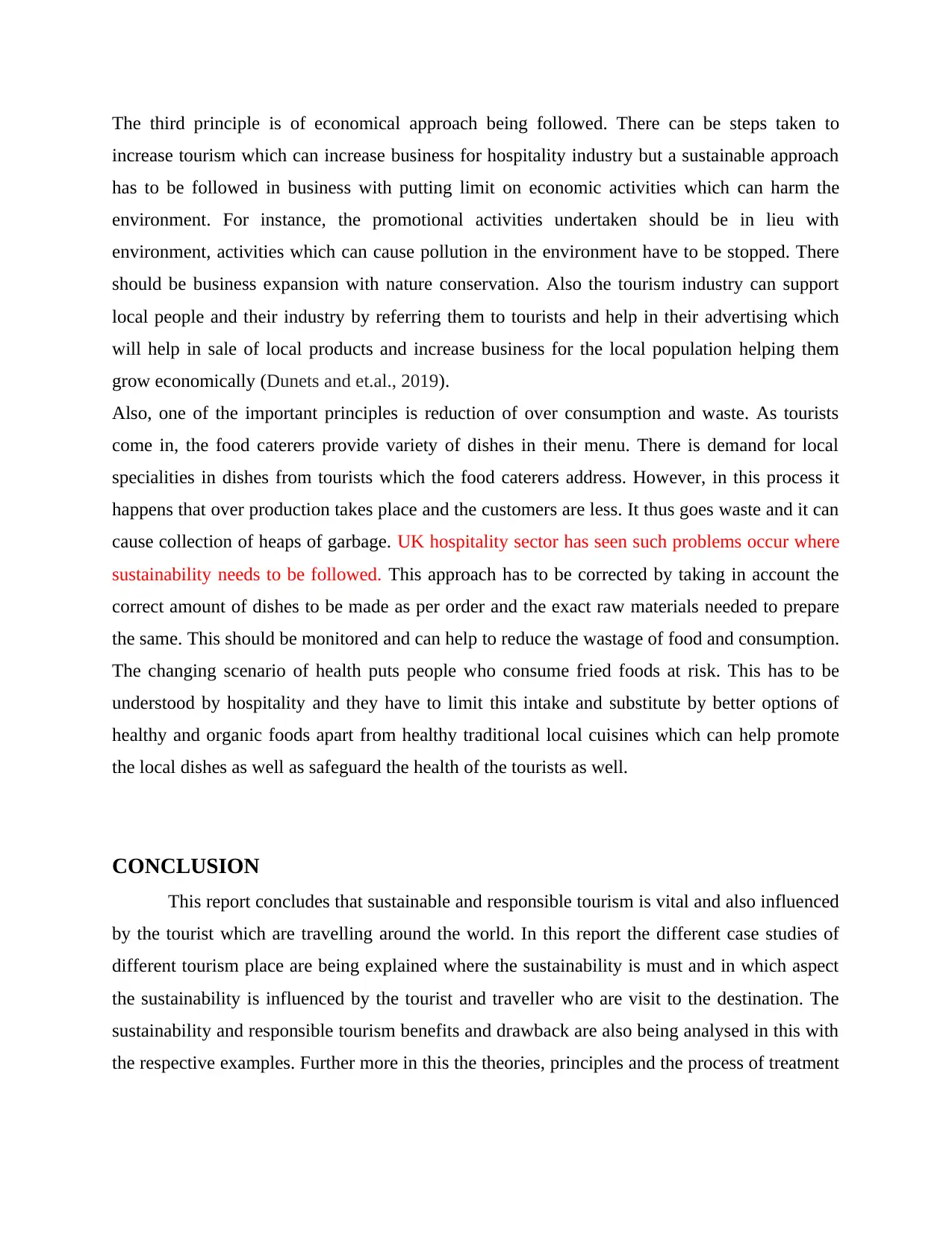
The third principle is of economical approach being followed. There can be steps taken to
increase tourism which can increase business for hospitality industry but a sustainable approach
has to be followed in business with putting limit on economic activities which can harm the
environment. For instance, the promotional activities undertaken should be in lieu with
environment, activities which can cause pollution in the environment have to be stopped. There
should be business expansion with nature conservation. Also the tourism industry can support
local people and their industry by referring them to tourists and help in their advertising which
will help in sale of local products and increase business for the local population helping them
grow economically (Dunets and et.al., 2019).
Also, one of the important principles is reduction of over consumption and waste. As tourists
come in, the food caterers provide variety of dishes in their menu. There is demand for local
specialities in dishes from tourists which the food caterers address. However, in this process it
happens that over production takes place and the customers are less. It thus goes waste and it can
cause collection of heaps of garbage. UK hospitality sector has seen such problems occur where
sustainability needs to be followed. This approach has to be corrected by taking in account the
correct amount of dishes to be made as per order and the exact raw materials needed to prepare
the same. This should be monitored and can help to reduce the wastage of food and consumption.
The changing scenario of health puts people who consume fried foods at risk. This has to be
understood by hospitality and they have to limit this intake and substitute by better options of
healthy and organic foods apart from healthy traditional local cuisines which can help promote
the local dishes as well as safeguard the health of the tourists as well.
CONCLUSION
This report concludes that sustainable and responsible tourism is vital and also influenced
by the tourist which are travelling around the world. In this report the different case studies of
different tourism place are being explained where the sustainability is must and in which aspect
the sustainability is influenced by the tourist and traveller who are visit to the destination. The
sustainability and responsible tourism benefits and drawback are also being analysed in this with
the respective examples. Further more in this the theories, principles and the process of treatment
increase tourism which can increase business for hospitality industry but a sustainable approach
has to be followed in business with putting limit on economic activities which can harm the
environment. For instance, the promotional activities undertaken should be in lieu with
environment, activities which can cause pollution in the environment have to be stopped. There
should be business expansion with nature conservation. Also the tourism industry can support
local people and their industry by referring them to tourists and help in their advertising which
will help in sale of local products and increase business for the local population helping them
grow economically (Dunets and et.al., 2019).
Also, one of the important principles is reduction of over consumption and waste. As tourists
come in, the food caterers provide variety of dishes in their menu. There is demand for local
specialities in dishes from tourists which the food caterers address. However, in this process it
happens that over production takes place and the customers are less. It thus goes waste and it can
cause collection of heaps of garbage. UK hospitality sector has seen such problems occur where
sustainability needs to be followed. This approach has to be corrected by taking in account the
correct amount of dishes to be made as per order and the exact raw materials needed to prepare
the same. This should be monitored and can help to reduce the wastage of food and consumption.
The changing scenario of health puts people who consume fried foods at risk. This has to be
understood by hospitality and they have to limit this intake and substitute by better options of
healthy and organic foods apart from healthy traditional local cuisines which can help promote
the local dishes as well as safeguard the health of the tourists as well.
CONCLUSION
This report concludes that sustainable and responsible tourism is vital and also influenced
by the tourist which are travelling around the world. In this report the different case studies of
different tourism place are being explained where the sustainability is must and in which aspect
the sustainability is influenced by the tourist and traveller who are visit to the destination. The
sustainability and responsible tourism benefits and drawback are also being analysed in this with
the respective examples. Further more in this the theories, principles and the process of treatment
⊘ This is a preview!⊘
Do you want full access?
Subscribe today to unlock all pages.

Trusted by 1+ million students worldwide

of sustainable and responsible tourism are analysed. Moreover, in this the destination based
sustainability and tourism hospitality organization sustainability are being discussed.
sustainability and tourism hospitality organization sustainability are being discussed.
Paraphrase This Document
Need a fresh take? Get an instant paraphrase of this document with our AI Paraphraser
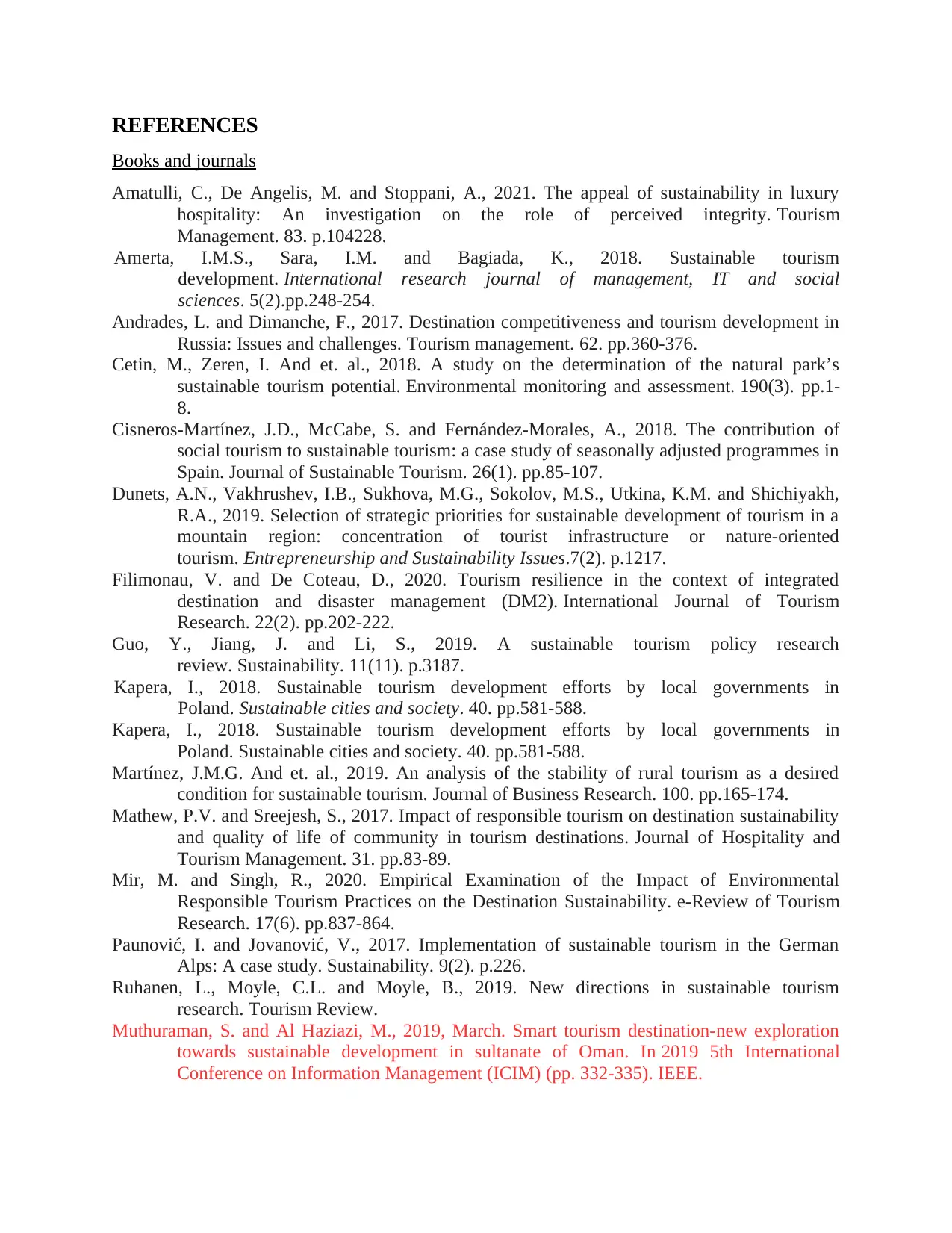
REFERENCES
Books and journals
Amatulli, C., De Angelis, M. and Stoppani, A., 2021. The appeal of sustainability in luxury
hospitality: An investigation on the role of perceived integrity. Tourism
Management. 83. p.104228.
Amerta, I.M.S., Sara, I.M. and Bagiada, K., 2018. Sustainable tourism
development. International research journal of management, IT and social
sciences. 5(2).pp.248-254.
Andrades, L. and Dimanche, F., 2017. Destination competitiveness and tourism development in
Russia: Issues and challenges. Tourism management. 62. pp.360-376.
Cetin, M., Zeren, I. And et. al., 2018. A study on the determination of the natural park’s
sustainable tourism potential. Environmental monitoring and assessment. 190(3). pp.1-
8.
Cisneros-Martínez, J.D., McCabe, S. and Fernández-Morales, A., 2018. The contribution of
social tourism to sustainable tourism: a case study of seasonally adjusted programmes in
Spain. Journal of Sustainable Tourism. 26(1). pp.85-107.
Dunets, A.N., Vakhrushev, I.B., Sukhova, M.G., Sokolov, M.S., Utkina, K.M. and Shichiyakh,
R.A., 2019. Selection of strategic priorities for sustainable development of tourism in a
mountain region: concentration of tourist infrastructure or nature-oriented
tourism. Entrepreneurship and Sustainability Issues.7(2). p.1217.
Filimonau, V. and De Coteau, D., 2020. Tourism resilience in the context of integrated
destination and disaster management (DM2). International Journal of Tourism
Research. 22(2). pp.202-222.
Guo, Y., Jiang, J. and Li, S., 2019. A sustainable tourism policy research
review. Sustainability. 11(11). p.3187.
Kapera, I., 2018. Sustainable tourism development efforts by local governments in
Poland. Sustainable cities and society. 40. pp.581-588.
Kapera, I., 2018. Sustainable tourism development efforts by local governments in
Poland. Sustainable cities and society. 40. pp.581-588.
Martínez, J.M.G. And et. al., 2019. An analysis of the stability of rural tourism as a desired
condition for sustainable tourism. Journal of Business Research. 100. pp.165-174.
Mathew, P.V. and Sreejesh, S., 2017. Impact of responsible tourism on destination sustainability
and quality of life of community in tourism destinations. Journal of Hospitality and
Tourism Management. 31. pp.83-89.
Mir, M. and Singh, R., 2020. Empirical Examination of the Impact of Environmental
Responsible Tourism Practices on the Destination Sustainability. e-Review of Tourism
Research. 17(6). pp.837-864.
Paunović, I. and Jovanović, V., 2017. Implementation of sustainable tourism in the German
Alps: A case study. Sustainability. 9(2). p.226.
Ruhanen, L., Moyle, C.L. and Moyle, B., 2019. New directions in sustainable tourism
research. Tourism Review.
Muthuraman, S. and Al Haziazi, M., 2019, March. Smart tourism destination-new exploration
towards sustainable development in sultanate of Oman. In 2019 5th International
Conference on Information Management (ICIM) (pp. 332-335). IEEE.
Books and journals
Amatulli, C., De Angelis, M. and Stoppani, A., 2021. The appeal of sustainability in luxury
hospitality: An investigation on the role of perceived integrity. Tourism
Management. 83. p.104228.
Amerta, I.M.S., Sara, I.M. and Bagiada, K., 2018. Sustainable tourism
development. International research journal of management, IT and social
sciences. 5(2).pp.248-254.
Andrades, L. and Dimanche, F., 2017. Destination competitiveness and tourism development in
Russia: Issues and challenges. Tourism management. 62. pp.360-376.
Cetin, M., Zeren, I. And et. al., 2018. A study on the determination of the natural park’s
sustainable tourism potential. Environmental monitoring and assessment. 190(3). pp.1-
8.
Cisneros-Martínez, J.D., McCabe, S. and Fernández-Morales, A., 2018. The contribution of
social tourism to sustainable tourism: a case study of seasonally adjusted programmes in
Spain. Journal of Sustainable Tourism. 26(1). pp.85-107.
Dunets, A.N., Vakhrushev, I.B., Sukhova, M.G., Sokolov, M.S., Utkina, K.M. and Shichiyakh,
R.A., 2019. Selection of strategic priorities for sustainable development of tourism in a
mountain region: concentration of tourist infrastructure or nature-oriented
tourism. Entrepreneurship and Sustainability Issues.7(2). p.1217.
Filimonau, V. and De Coteau, D., 2020. Tourism resilience in the context of integrated
destination and disaster management (DM2). International Journal of Tourism
Research. 22(2). pp.202-222.
Guo, Y., Jiang, J. and Li, S., 2019. A sustainable tourism policy research
review. Sustainability. 11(11). p.3187.
Kapera, I., 2018. Sustainable tourism development efforts by local governments in
Poland. Sustainable cities and society. 40. pp.581-588.
Kapera, I., 2018. Sustainable tourism development efforts by local governments in
Poland. Sustainable cities and society. 40. pp.581-588.
Martínez, J.M.G. And et. al., 2019. An analysis of the stability of rural tourism as a desired
condition for sustainable tourism. Journal of Business Research. 100. pp.165-174.
Mathew, P.V. and Sreejesh, S., 2017. Impact of responsible tourism on destination sustainability
and quality of life of community in tourism destinations. Journal of Hospitality and
Tourism Management. 31. pp.83-89.
Mir, M. and Singh, R., 2020. Empirical Examination of the Impact of Environmental
Responsible Tourism Practices on the Destination Sustainability. e-Review of Tourism
Research. 17(6). pp.837-864.
Paunović, I. and Jovanović, V., 2017. Implementation of sustainable tourism in the German
Alps: A case study. Sustainability. 9(2). p.226.
Ruhanen, L., Moyle, C.L. and Moyle, B., 2019. New directions in sustainable tourism
research. Tourism Review.
Muthuraman, S. and Al Haziazi, M., 2019, March. Smart tourism destination-new exploration
towards sustainable development in sultanate of Oman. In 2019 5th International
Conference on Information Management (ICIM) (pp. 332-335). IEEE.
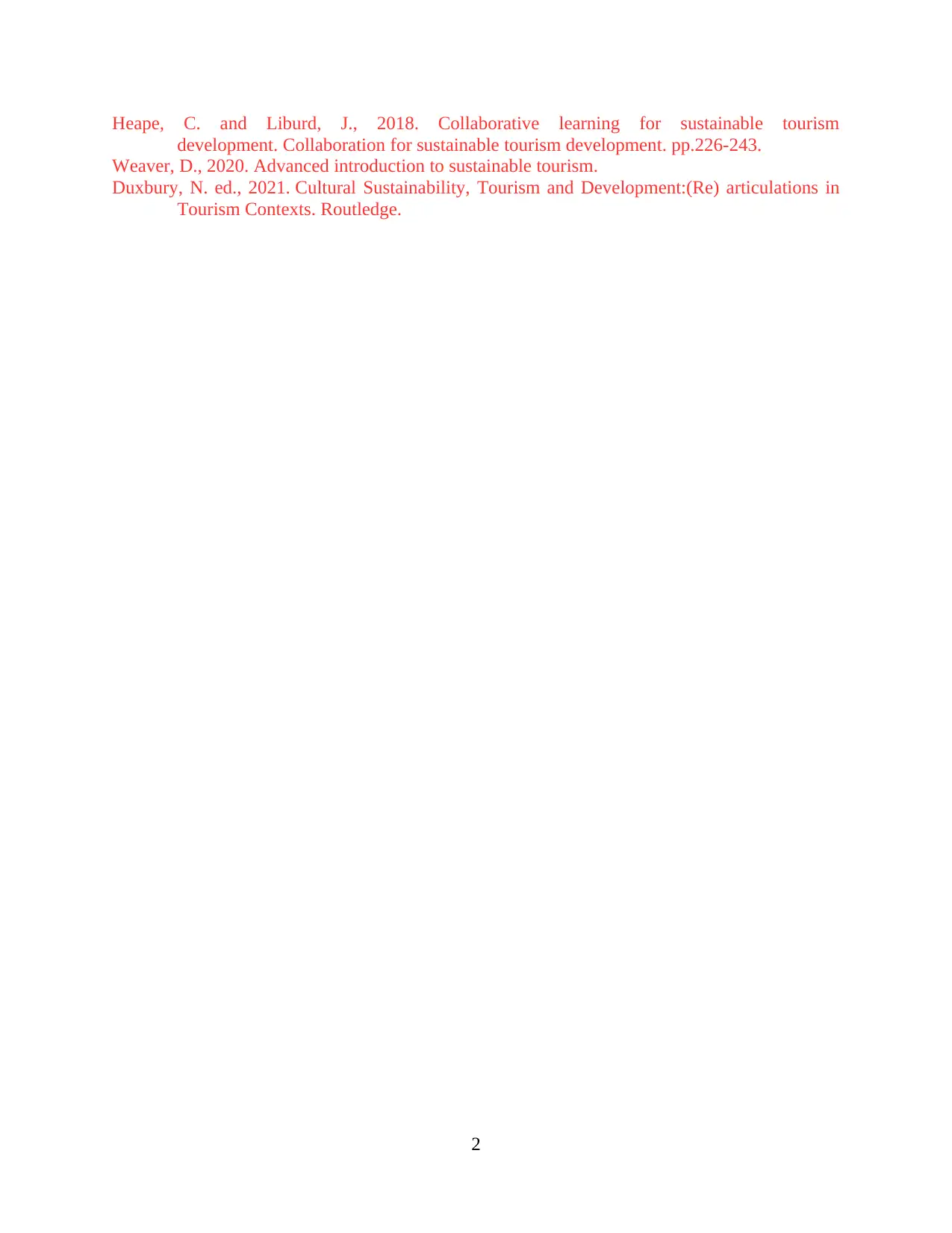
Heape, C. and Liburd, J., 2018. Collaborative learning for sustainable tourism
development. Collaboration for sustainable tourism development. pp.226-243.
Weaver, D., 2020. Advanced introduction to sustainable tourism.
Duxbury, N. ed., 2021. Cultural Sustainability, Tourism and Development:(Re) articulations in
Tourism Contexts. Routledge.
2
development. Collaboration for sustainable tourism development. pp.226-243.
Weaver, D., 2020. Advanced introduction to sustainable tourism.
Duxbury, N. ed., 2021. Cultural Sustainability, Tourism and Development:(Re) articulations in
Tourism Contexts. Routledge.
2
⊘ This is a preview!⊘
Do you want full access?
Subscribe today to unlock all pages.

Trusted by 1+ million students worldwide
1 out of 15
Related Documents
Your All-in-One AI-Powered Toolkit for Academic Success.
+13062052269
info@desklib.com
Available 24*7 on WhatsApp / Email
![[object Object]](/_next/static/media/star-bottom.7253800d.svg)
Unlock your academic potential
Copyright © 2020–2025 A2Z Services. All Rights Reserved. Developed and managed by ZUCOL.


